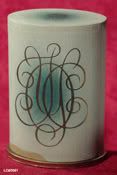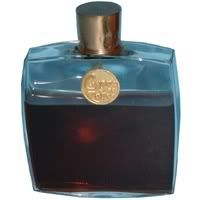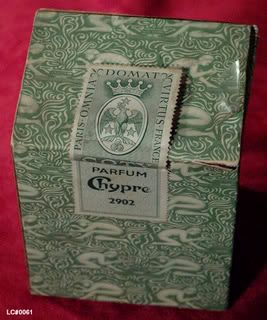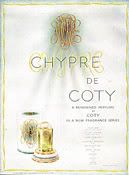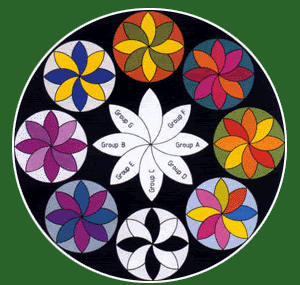It has long been my opinion that fragrances do not merely reflect their makers' vision or the desire to attain beauty and harmony through an ethereal means such as the fume of a precious liquid. They are routinely shaped by the circumstances that define much of the popular culture around us; they take form from the spirit of the moment, the zeitgeist. Hegel would have turned in his grave hearing us applying his
Philosophy of History term applied to fragrance, but nevertheless it always seemed appropriate to me. Because, if you really think about it, aren't scents the expression of cultural tendencies and the aspirational
mores of the ethos of select segments in society?
Thus,
chypre fragrances evolved through a particular cultural necessity that alternately dictated allegience to forces of cool earthiness, or feminine powderiness or elegant sophistication. Although chypres have been in existence since antiquity, as previously discussed, it is most fascinating to contemplate their evolution in the 20th century.
Contrary to popular perception,
François Coty was not the first to associate the name
Chypre with a particular perfume in 1917. Guerlain's
Chypre de Paris preceded him by 8 years, issued in as early as 1909.
Chypre d'Orsay was the next one to be introduced, in 1912. However it was Coty's that really took off and became an instant commercial success that created traction and a vogue for such heavy "green" perfumes. It was also the year when Caron launched their
Tabac Blond, a daring concept at the time, encouraging women to smell like they smoke, considered terribly chic then.
It was the time before the Great War, when disillusionment had not set in and the introduction of
the exotic, sensual mystique of the East hadn't budded yet. It would take legendary
Mitsouko by, Guerlain in 1919, inspired by a Japanese heroine in the then best-selling novel "La Bataille" to do that. The success of
Les ballets Russes under impressario Diaghilev's artistic baguette (who incidentally loved
Mitsouko and used it on his hotel curtains) brought on the vogue for orientals
in the 1920s, as manifested by the roaring success of khol-eyed
Shalimar. Suddenly everything oriental hinted at abandon and sensuality, the forbidden territory in which "flappers", the independent women of the time, marched through with renewed confidence.
Chypres and tobacco scents provided also a backdrop for confidence and individualism that marked this new era in women's emancipation. Long pipes of ebony and ivory were often held in elegant hands that bore the glamorous manicure of the times and the dark lips that recalled
Theda Bara. Molinard's
Le Chypre was introduced in 1925 and in 1933 Jacques Guerlain launched
Sous le Vent to capture the soul of
artiste Josephine Baker, the woman who shocked Americans and mesmerised the Paris audiences. (You can read a full review of
Sous le vent clicking here).
The leathery chypre of Chanel,
Cuir de Russie, was brought out in 1924, using birch tar as the note that skyrocketed it into the realm of utter sophistication.
As
the great Crash crashed hopes of affluence and resurgence for the masses,chypres lost some of their cachet in favour of more economical propositions, at least in the United States. However perusing lists of perfume houses from the perior 1919 up to 1949, we see that every one of them had some chypre fragrance listed in their catalogues. Obviously this was a family that was considered
sine qua non for perfume makers. It was often that they married the classic chypre accord with flowers, such as rose, jasmine, carnation, heliotrope or geranium, to render a more feminine note.
Contrast this with today's world in which the name Chypre is associated with more obscure or niche fragrance marketers such as Vivienne, Scientex, Arys, Montale, E.N.Z., Peckinsniffs, and Patyke. They take the heritage of Coty's success with them, but they are not at the front row of fashion. On the other hand, maybe the lack of such identical nomenclature in commercial scents has to do with marketing strategies that point to the direction of more original names that would differentiate products from one another among brands (the fact that they are not that differentiated among the offering of the same brand, what with the flankers of 1, 2, light, summer etc. is fodder for another post).
In the difficult years of World War II, it was
the genius of Edmond Roudnitska that saw the potential of a long forgotten vat of methyl ionone that smelled of prunes in the factory that he was working trying to find such exciting things as butter substitute and such due to the privations of war.
Femme was the dense fruity chypre of 1944 that recalled an upscale confectionary shop and which became the first perfume of couturier Marchel Rochas, a wedding present to his beautiful young bride.
It is interesting to contrast this with the dyke-y creation of
nez extraordinaire Germaine Cellier
Bandit for Rober Piguet issued in the same year. An ox-feller of a leathery chypre,
Bandit was inspired by the panties that models wore exiting the runway; which according to Cellier was "when they let out the best of their femininity". It is no secret that Cellier was a homosexual...
Bandit was a proud creation that unabashedly confirms the aloofness of intense vetiver and patchouli smeared on used leather and with the echo of moss and flowers in the background. One can picture it on an interesting woman or a daring man. They have to be so to begin with, though, and not hoping to graft the image onto themselves through perfume.
After World War II, chypres saw a reigning period again according to perfume writer Michael Edwards, this time in the guise of less orientalised variations that were removed from the mystery of
Mitsouko and more into the powderiness or the couture elegance that was depicted in
Ma Griffe and
Miss Dior.
Ma Griffe was another post-War chypre, a true masterpiece by nose Jean Carles for the house of Carven. Very powdery dry and quite spicy thanks to the weird note of styrax,
Ma Griffe managed to be assertive in its name (it means "my signature", but also "my talon") and supremely sparkly and feminine in its aroma. It marked the introduction of chypres into the arena of professional women. Those were not factory workers of the war or flappers; they were secretaries at the new firms; twin set in place, string of pearls and a slick of lipstick on impecably powdered faces. The psychology of those new chypres talked about women who earned their living by themselves, but did not manifest themselves as sexual predators. There is a sense of detachment and intelligence.
Christian Dior had just launched the New Look in 1947 that took trainloads of fabric to new heights of spending, in an effort to maximise fabric sales but also to inject a hopeful touch into the hearts of women who had bid farewell to the rationed days of the war.( It is an old adage by Yves Saint Laurent that in times of economic shortage couturiers use a bit more fabric to boost the market, whereas in times of economic affluence -such as the 60s- the shorter length is king).
Miss Dior became a best-seller and a crowd pleaser that managed not to sit on the fence, but to take an animalistic backdrop and smother it with soft flowers such as gardenia, narcissus, lily of the valley and green touches of galbanum and aldeydes. It spoke of a new elegance and a subdued sensuality that was not aggressive like that of the flappers, but more pedigreed and delicate, yet undeniably naughty underneath especially in the glorious parfum/extrait concentration.
Well
into the 50s, chypres were popular.
Jolie Madame was another product of Germaine Cellier, in 1953, that reprised the animalic, leathery theme; this time with very green and violety notes that cede to a big box of talcum powder. This is definitely a turn to the more restrained and professional as befited the times.
Cabochard for Gres by Bernand Chant in 1959 was more devil-may-care in attitude. Obviously there were different types of women to be catered for with the era's chypres and this one was destined for those who were powerful and dominant. Madame Gres said she was inspired by a trip to India. The bitter orange opening on spice and leather and the powdery depths beguiled and asserted themselves in the memory of anyone smelling it. Reformulated in later years, it has been irrecovably ruined, I am afraid. It is a pity, as it used to have a very individual character, hard to mimic, although it does bear some relation to another of Bernard Chant's offerings,
Aromatics Elixir by Clinique.
In 1961, Guy Robert created
Caleche for the house of Hermes, inspired by a fine type of carriage. The quiet resonance of this scent was completely in tune with the times, exuding copious amount of good taste while remaining tame with its sensuality under wraps; a cladestine affair was not in the programme, but should it ever happen it would remain a very well-kept secret. The sparkle of aldehydes mid-way between two trends, floral and chyprish, gave a fizziness that was also popular at the times, imbuing the whole with a feminine touch that was distinctly Parisian.
But
the 1960s was a different time. Although they begun in the soft powdwery florals and the aldehydics, soon Mary Quant with the mini, the Beatles and the hippy movement and the ravages of war in Vietnam and the politics of the time swang the pendulum in another direction that meant another mentality in perfume. Nature and the smells of the body were explored in simple oils, headshop ones, such as straight patchouli and aromas that had a "pot" aroma to them. Clearly this was another page.
It was not until
the 1970s when chypres dominated the perfume scene again, as a second wave of women's emancipation came to the fore. The kickstart was given by
Chanel No.19, a fragrance that is traditionally classified as a green floral, created by Henri Robert for Coco Chanel herself (and overviewed by her from beginning to end), later to be publicly launched. However among the different concentrations one can feel a chyprish quality in the drier, more iris-vetiver rich eau de toilette, whereas the eau de parfum is rosier and more floral. In parfum/extrair concentration there is such dry depth that it re-affirms its position at the top of my list for elegant fragances for confident women. It seemed that it created an avalanche of chypres, dry, crisp and cerebral this time, echoing the new status of women who needed men "as much as fish needed bicycles".
Diorella was another legendary Roudnitska creation that remains enigmatic and minimalistic to this day. It begun as an attempt to capitalise on the trend of women wearing men's scents, which had started with yet another Roudnitska creation,
Eau Sauvage for Dior.
Diorella was to be the more feminine sister scent so that women could claim it as their own. Too crisp and fresh with its lemon opening and its fruity greeness for it to be really sensual, but an elegant insouciant fragrance for the young women who wore trousers and set out to rule the world. The latter image was best depicted by
Charlie, that best-seller by Revlon (1973), which revolutionised advertising, depicting women in pants for the first time and focusing on the sheer power and confidence that it gave women who didn't need a man to be successful. It was trully revolutionary, at least conceptually!
Aromatics Elixir for Clinique and
Alliage for Lauder (both in 1972),
Coriandre by Jean Couturier (with the addition of a large percentage of magnolione, a material similar to hedoine but with more of a jasmine quality) and
Private Collection by Lauder (both in 1973) and finally
Halston in 1975; all saw this new trend take shape.
Interestingly Givenchy brought out
Givenchy Gentleman in 1974, a masculine chypre full of pungent patchouli and a true masterpiece of calculated olfactory assault that married tarragon, vetiver and russian leather, showing that men could project the traditional assured image themselves still.
As the decade was coming to an end, the
hyber success of spicy oriental
Opium meant a new direction that would take
the carnal and affluent capitalistic 80s into new avenues of perfume exhibitionism. The sophistication and powderiness of chypres took a backseat to such bombastic examples as
Obsession, Giorgio and
Poison.
However they did not completely disappear, with cerebral examples that encompassed Ungaro's rosy bombshell
Diva in 1982,
Niki de saint Phalle (the 1984 creation of a talented sculptor famous for her snakes and bearing those on the bottle),
Knowing by Lauder in 1988 (inspired by the smell of pittosporum smelled during holidays in the south of France) and
La perla by luxe lingerie brand in 1986.
In the masculine field,
Drakkar Noir by Guy Laroche was launched in 1982; a
fougere scent (with borrowed elements off the very herbal chypres) that took the name of Viking ships to emphasize masculinity and which sported tangy verbena and lemon rind with a herbal heart of coriander, lavender and juniper berries on bottom notes of patchouli, sandalwood and fir balsam. It proved to be a bestseller in the corporate world of the Wall-Street-decade.
Nevertheless, the most memorable example of the decade in the category of chypres is perhaps
Paloma Picasso, Pablo's daughter's foray into perfumery which was imbued with her unique, bold style and matched her Spanish roots and signature red lips: assured. It brought the animalic quality of castoreum into the vogue again interpreting it into a domineering personality that made Montana follow suit with his
Parfum de Peau in the blue box in 1986, with its beautiful bottle inspired by the swirling fall of a winged sycamore seed as seen by a strobe light, designed by Serge Mansau. Magnificently intense and terribly potent it was perhaps the last chypre chronologically to make the aggressive mark.
By
the 90s, things changed again as the baby boom took place and there was a regression to simpler things, a call to nature, a desire to leave urbanity behind and revel into acqueous and ozonic notes that promised the much longed for escape.
The chypres that came out then were mostly fruitier, tamer, sweeter blends such as the fizzy fruit salad of Sophia Grojsman for Yves Saint Laurent's
Yvresse (originally named
Champagne) or the underrated
Deci Dela by Nina Ricci in 1994.
It was clear by then that chypres had had their heyday and consumers were opting for different things, terming chypres old-fashioned and almost archaic.
Yet this esteemed category has not uttered its final word. As discussed previously in The New Contestants article, "modern" chypres are out to take revenge for their illustrious ancestors and although they are markedly different than them, they are still a hope that the zeitgeist is again changing, favouring heavier, richer, more mysterious scents that demand a wink in the eye and a steely shoulder to cry upon. Let's hope that a return to truer chypres is not far off.
NEXT POST: a perfume legend gets reviewed. Stay tuned!
pic of Mitsouko ad from the 1960s originally uploaded on mua, pic of Diorella and Miss Dior ad from psine.net



.jpg)

